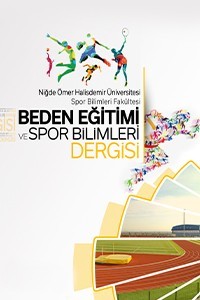HIGH PREVALENCE OF VITAMIN D DEFICIENCY IN ASYMPTOMATIC RECREATIONAL ATHLETES
Vitamin D, Sports Nutrition, Sports Medicine, Sports Health
___
- Chung M, Lee J, Terasawa T, Lau J, Trikalinos TA. (2011). Vitamin D with or without calcium supplementation for prevention of cancer and fractures: An updated meta-analysis for the U.S. Preventive Services Task Force. Annals of Internal Medicine. 155(12), 827-838.
- Close GL, Russell J, Cobley JN, Owens DJ, Wilson G, Gregson W, Fraser WD, Morton JP. (2013). Assessment of vitamin D concentration in non-supplemented professional athletes and healthy adults during the winter months in the UK: implications for skeletal muscle function. Journal of Sports Sciences. 31(4), 344-353.
- Dahlquist DT, Dieter BP, Koehle MS. (2015). Plausible ergogenic effects of vitamin D on athletic performance and recovery. Journal of the International Society of Sports Nutrition. 12, 33.
- Daugaard S, Garde AH, Hansen ÅM, Vistisen HT, Rejnmark L, Kolstad HA. (2018). Indoor, outdoor, and night work and blood concentrations of vitamin D and parathyroid hormone. Scandinavian Journal of Public Health. 44(6), 647-657.
- Durup D, Jørgensen HL, Christensen J, Schwarz P, Heegaard AM, Lind B. (2012). A reverse j-shaped association of all-cause mortality with serum 25-hydroxyvitamin D in general practice: The copd study. The Journal of Clinical Endocrinology & Metabolism. 97(8), 2644-2652.
- Goswami R, Saha S, Sreenivas V, Singh N, Lakshmy R. (2017). Vitamin D-binding protein, vitamin D status and serum bioavailable 25(OH)D of young Asian Indian males working in outdoor and indoor environments. Journal of Bone and Mineral Metabolism. 35(2), 177-184.
- Heaney RP. (2008). Vitamin D: Criteria for safety and efficacy. Nutrition Reviews. 66(2),178-181.
- Holick MF, Binkley NC, Bischoff-Ferrari HA, Gordon CM, Hanley DA, Heaney RP, Murad MH, Weaver CM. (2011). Evaluation, treatment, and prevention of vitamin D deficiency: An endocrine society clinical practice guideline. The Journal of Clinical Endocrinology & Metabolism. 96(7), 1911-1930.
- Hossein-nezhad A, Holick MF. (2013). Vitamin D for health: A global perspective. Mayo Clinic Proceedings. 88(7), 720-755.
- Lappe J, Cullen D, Haynatzki G, Recker R, Ahlf R, Thompson K. (2008). Calcium and vitamin D supplementation decreases incidence of stress fractures in female navy recruits. Journal of Bone and Mineral Research. 23(5), 741-749.
- Larson-Meyer DE, Woolf K, Burke L. (2018). Assessment of nutrient status in athletes and the need for supplementation. International Journal of Sport Nutrition and Exercise Metabolism. 28(2), 139-158.
- Maughan RJ, Burke LM, Dvorak J, Larson-Me yer DE, Peeling P, Phillips SM, Rawson ES, Walsh NP, Garthe I, Geyer H, Meeusen R, van Loon LJC, Shirreffs SM, Spriet LL, Stuart M, Vernec A, Currell K, Ali VM, Budgett RG, Ljungvist A, Mountjoy M, Pitsiladis YP, Soligard T, Erdener U, Engebretsen L. (2018). IOC consensus statement: dietary supplements and the high-performance athlete. British Journal of Sports Medicine. 52(7), 439-455.
- Mithal A, Bonjour J-P, Boonen S, Burckhardt P, Degens H, El Hajj Fuleihan G, Josse R, Lips P, Morales Torres J, Rizzoli R, Yoshimura N, Wahl DA, Cooper C, Dawson-Hughes B. (2013). Impact of nutrition on muscle mass, strength, and performance in older adults. Osteoporosis International. 24(5), 1555-1566.
- Ogan D, Pritchett K. (2013). Vitamin D and the athlete: Risks, recommendations, and benefits. Nutrients. 5(6), 1856-1868.
- Pilz S, Tomaschitz A, März W, Drechsler C, Ritz E, Zittermann A. (2011). Vitamin D, cardiovascular disease and mortality. Clinical Endocrinology 75(5), 575-584.
- Pludowski P, Holick MF, Pilz S, Wagner CL, Hollis BW, Grant WB, Shoenfeld Y, Lerchbaum E, Llewellyn DJ, Kienreich K, Soni M. (2013). Vitamin D effects on musculoskeletal health, immunity, autoimmunity, cardiovascular disease, cancer, fertility, pregnancy, dementia and mortality—A review of recent evidence. Autoimmunity Reviews. 12(10), 976-989.
- Ruohola J-P, Laaksi I, Ylikomi T, Haataja R, Mattila VM, Sahi T, Tuohimaa P, Pihlajamaki H. (2006). Association between serum 25(OH)D concentrations and bone stress fractures in finnish young men. Journal of Bone and Mineral Research. 21(9), 1483-1488. Sikora-Klak J, Narvy SJ, Yang J, Makhni E, Kharrazi FD, Mehran N. (2018). The effect of abnormal vitamin D levels in athletes. The Permanente journal 22(17), 216
- Team RC. R: A language and environment for statistical computing. 2018. https://www.r-project.org/.%0A.
- Zeitler C, Fritz R, Smekal G, Ekmekcioglu C. (2018). Association between the 25-hydroxyvitamin D status and physical performance in healthy recreational athletes. International Journal of Environmental Research and Public Health. 15(12), 2724.
- ISSN: 1307-6477
- Yayın Aralığı: Yılda 3 Sayı
- Başlangıç: 2007
- Yayıncı: Niğde Ömer Halisdemir Üniversitesi
Bekir ÇAR, Yunus Emre YARAYAN, Ekrem Levent İLHAN, Nevin ATALAY GÜZEL
Mücahit DURSUN, Bahar GÜLER, Tuğba MUTLU BOZKURT
FUTBOLCULARDA BCAA VE KREATİN ALIMININ VÜCUT KOMPOZİSYONU ÜZERİNE ETKİSİ
Ahmet MOR, Gökhan İPEKOĞLU, Kadir BAYNAZ, Cansel ARSLANOĞLU, Kürşat ACAR, Erkal ARSLANOĞLU
BEDEN EĞİTİMİ VE SPOR DERSİ VE İLKÖĞRETİM SEKİZİNCİ SINIF ÖĞRENCİLERİNDE DEĞERLER EĞİTİMİ
Mustafa KELEŞ, Oğuzhan YONCALIK
INVESTIGATION THE EFFECT OF FOOTWORK ON STRENGTH AND AGILITY PARAMETERS OF BADMINTON PLAYERS
Mehmet Fatih YÜKSEL, Latif AYDOS
HIGH PREVALENCE OF VITAMIN D DEFICIENCY IN ASYMPTOMATIC RECREATIONAL ATHLETES
Melda Pelin YARGIÇ, Galip Bilen KÜRKLÜ
GENÇ HALK OYUNLARI DANSÇILARININ DENGE PERFORMANSLARININ BELIRLENMESI
Yeliz YOL, Gülbin RUDARLI NALÇAKAN, Bora OKDAN, Mesut NALÇAKAN
